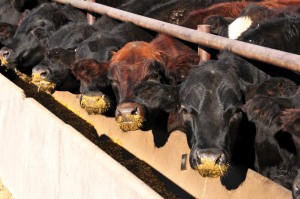-by Dick Carlson, Colorado and Southern Wyoming District Sales Manager
Often times when visiting customers at the feedlot, dairy or ranch they confront us with questions, such as:
- Is this feed worth the price being asked?
- How do I determine the value of the feed source from a feed test?
- What is important to review when I receive results from the lab?

Regardless of whether or not feeds are expensive, we must determine the best feed for the value of a given nutrient. Whether feeding cows or feeder cattle we must put a pencil to the ration to determine the best feeds to incorporate, based
on the dollar value of that nutrient provided
to the animal. Following is a list to be used when determining which nutrients should be purchased at a particular price.
- Inventory feed currently available on-hand.
- Determine the rations needed to identify the amount of total feed required.
- Determine when you will feed your best and worst rations.
- Test your feeds to identify the nutrients lacking in those diets.
- Determine the best value of requireed nutrients based on dry matter.
- Know the cost of transporting feeds, especially wet feeds.
- Determine the palatability of the feed and potential waste.
Feeds cannot be compared fairly based on price alone. The lowest priced feed may not be the most economical feed in the long run. Evaluating the additional supplements your customers will need to purchase is esstential in providing what the cheap feed is not. To determine if the feed is right, first look at the dry matter cost of the particular feed.
Also, we need to determine which nutrient, such as protein or energy, the feed lacks when developing a ration for a certain group of
animals. Let’s work through a few examples.
Example 1:
Alfalfa priced at $160/ton; 18% crude protein (CP);
56 total digestible nutrients (TDN); 87% dry matter (DM).
Cost/ton of DM: $160/ton / 20 cwt / .87 = $9.20/cwt DM
Cost/pound of CP: $9.20/cwt DM / 18% CP = $0.51/lb. CP
Cost/pound of TDN: $9.20/cwt DM / 56% TDN = $0.165/lb. TDN
Comparing corn with distillers grain is a common practice, which reinforces why we need to identify the moisture and the cost of transporting that feed. Example 2 only compares moisture, but to go further protein and energy should also be compared when considering wet distillers.
Example 2:
Corn priced at $4.60/bu; Wet distillers grain delivered at $69.80/ton
Corn: $4.60/bu / 56 (lb/bu) / .845(15.5% DM) x 20 cwt = $194.42/ton
WDG: $59.80/ton + $10/ton freight / .35(35% DM) = $199.43/ton
Obviously, there are other things to consider when selecting feeds. Some may be less expensive providing a good source of scratch for the rumen but have no feed value. Therefore, the remaining diet will need to be more dense with the other essential nutrients.
Or, let’s go for adding Hay Treat and make
poor feed a
usable commodity with additional protein. Additionally,
High Fat products provide a great solution to add energy with the side benefit of conditioning the ration.
The art to using different feedstuffs, whether poor or excellent quality, is
how we make the rations all fit together and be edible. Hopefully, working through these examples reinforces the need to balance rations and help you answer those questions during visits
to feedlots, dairies and ranches.
Dick Carlson can be reached at Dick.Carlson@allianceliquidfeeds.com.
